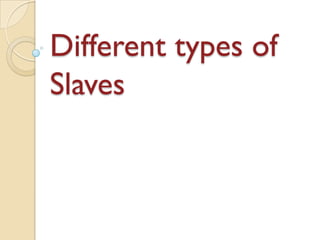
Different types of slaves
- 2. Slavery Slavery started in the 1600’s in North America. Slavery is a system in which people are bought and sold and forced to work. Slaves can be held against there will from the time of their capture, purchase or birth and nearly all slaves were not allowed to leave. Slavery emphasises the idea of complete ownership and control by a master. Often slaves were not paid.
- 3. Different types of slaves Different types of slaves. Slaves were bought for many different reasons. All slaves were given different jobs to do which were: Chattel Slavery: These kind of slaves could been traded, had no rights and were expected to perform labour and sexual favours to there masters command. Forced Labour: These slaves lived off the threat of them or there family being beaten. Serfdom: These slaves worked on the land. A serf was tied to the land and could not leave without their masters permission. A serf also required permission to marry, sell goods or change their occupation.
- 4. Debt Bondage slaves These slaves had to be kept as slaves to pay a debt for someone, usually a relative who was in debt. The debt could go on through generations, and it was unusual for slaves to escape their debt.
- 5. Forced Labour slaves. These slaves lived off the threat of them or there family being beaten.
- 6. Serfdom Slaves These slaves worked on the land. A serf was tied to the land and could not leave without their masters permission. A serf also required permission to marry, sell goods or change their occupation.
- 7. Dates of Slavery Slaves imported to American colonies[13] Date Numbers 1620-1700 21,000 1701-1760 189,000 1761-1770 63,000 1771-1790 56,000 1791-1800 79,000 1801-1810 124,000[14] 1810-1865 51,000 Total 597,00
- 8. Types of Slavery Life for a slave was very different depending on whether they were a field slave or a house slave. Field slaves and house slaves were different in many ways. Here are some differences between the two. Field Slaves Field slaves worked in the fields from sunrise to sunset, and at harvest time they toiled 18 hours a day. Woman worked the same hours as the men, and pregnant field slaves were expected to continue until their child was born. House Slaves House slaves usually lived more comfortably than field slaves. They usually had better food and were sometimes given the family’s used clothing. Even though it was illegal, some house slaves were educated by the woman in the family. Sometimes the house slaves were treated like the master’s child.